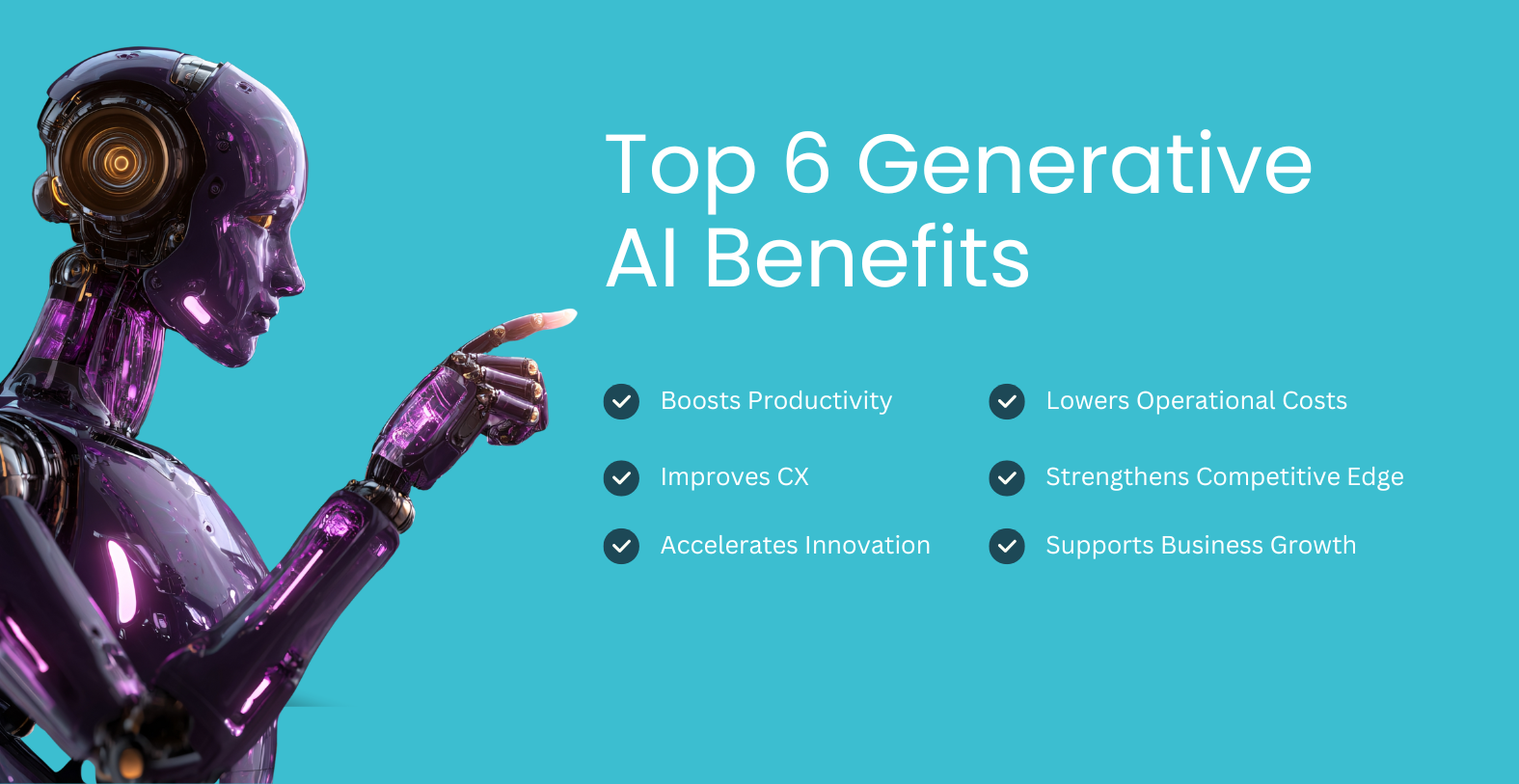Strategies to Integrate Generative AI in Business Workflow Effectively
Integrating generative AI needs careful planning, not just trial and error. This guide covers how to set clear goals, prepare your data, choose the right models, run pilot programs, and incorporate generative AI into your daily operations. It also explains how to scale these efforts across your organization to achieve measurable returns on investment.

Generative AI is now a core engine powering workflow automation, decision support, customer interactions, and content generation across enterprises. But integrating generative AI into business workflows isn’t as simple as plugging in a tool.
Most organizations struggle with legacy systems, unstructured data, unclear use cases, and the absence of an AI implementation roadmap. Without the right strategy, Generative AI deployments stall, create operational friction, and fail to deliver ROI.
This guide walks you through practical strategies to integrate generative AI in business workflows effectively, avoid common pitfalls, and accelerate your enterprise-wide GenAI adoption.
 Generate
Key Takeaways
Generating...
Generate
Key Takeaways
Generating...

- Identify high-impact GenAI use cases before integrating across workflows.
- Clean, compliant, accessible data is the foundation of every successful AI implementation.
- Start with pilots to validate assumptions, reduce risk, and refine workflows.
- Integrate AI with existing tools and business processes to enhance the core operations.
- Track KPIs, retrain models, and iterate continuously to scale GenAI effectively.
Top 6 Reasons to Consider Using Generative AI
Integrating generative AI can bring many benefits to your business, including improved data accuracy. Here are six key advantages:

1. Boosts Productivity & Efficiency: Generative AI helps automate routine tasks and content creation. A recent report says that generative AI could increase productivity in banking and financial services by up to 46% by 2030. This allows your team to focus on important initiatives that help your business grow.
2. Improves Customer Experience: Generative AI enables real-time, personalized interactions. It tailors product information and recommendations to each customer's preferences through AI-powered techniques, boosting satisfaction and loyalty.
A study of companies using generative AI for marketing and customer experience found that 49% of senior executives said AI helped them make better decisions. Additionally, 48% reported that generative AI improved customer engagement and personalization.
3. Accelerates Innovation: AI can generate new ideas and solutions, which may lead to the development of new products or services for your company.
4. Lowers Operational Costs: AI can handle repetitive tasks and complex processes, saving time and resources. This means you can reallocate budgets to other priorities while focusing on workflow automation.
5. Strengthens Competitive Advantage: Generative AI provides up-to-date insights from your operations and customer data. This helps you quickly adapt to market trends and customer needs.
6. Scales Seamlessly with Business Growth: Generative AI can manage larger workloads and data volumes as your business grows without needing to hire more staff or expand infrastructure. This makes it easier to scale your operations.
How to Integrate Generative AI in Business Workflow?
Integrating generative AI into a business workflow involves a clear, step-by-step plan. Start by setting specific goals and a clear generative AI integration strategy. Make sure your data is ready to use. Focus on teamwork to improve efficiency and spark innovation.
a) Plan Your Generative AI Integration Strategy
A successful gen AI integration starts with a clear plan focused on streamlining business processes and incorporating workflow automation instead of rushing into it.
b) Define Your Business Goals and Use Cases
Identify specific problems or time-consuming tasks where AI can help, like creating reports, producing content, or handling customer service questions. Clearly state the expected results and measurable goals (KPIs), such as "reduce customer response time by 25%" or "cut data entry errors by 50%."
c) Build a Diverse Team
Create a team with different skills. Include business managers who understand the company's goals, IT experts for technical needs, and data scientists or AI specialists to choose and train models. Your AI team should bring together:
- Business leaders for strategic decision-making
- IT & engineering teams for integration
- Data scientists/ML engineers for model selection & fine-tuning
- Compliance teams
d) Check Your Data
Generative AI is only as good as the data it trains on. Focus on:
- Data cleanliness
- Eliminating duplicates
- Ensuring accessibility
- Establishing compliance frameworks like GDPR, CCPA, or HIPAA
Review your data sources to ensure they are relevant, clean, and easy to access, as 80% of AI project time is spent just preparing and managing data.
e) Choose the Right AI Tools
Select AI workflow automation tools that fit your specific needs. This could mean choosing generative AI tools based on your internal capacity, workflow efficiency, and desired use cases:
- Pre-trained large language models (OpenAI, Anthropic, Google Gemini)
- Industry-specific models (healthcare, finance, legal)
- AI workflow automation platforms (Zapier AI, Make, UiPath Autopilot, Azure AI Studio)
Pick tools that integrate seamlessly with your CRM, ERP, ticketing systems, and communication apps.
Integrate GenAI Without Replacing Your Existing Systems
Plug AI into your current stack through secure, seamless API integrations.
AI Implementation Roadmap for Enterprises
Once your strategy is defined, a phased implementation helps manage risks and fosters user acceptance.
a) Start with a Pilot Project: Begin by running a small pilot project. Choose a low-risk project that can have a big impact in a controlled environment. This allows you to test how well the AI works with existing processes , get feedback, and make changes before a wider rollout.
b) Integrate with Existing Systems: Work with developers to connect the AI model to your current software and workflows. Use APIs or middleware to help the generative AI workflow automation with your existing systems.
c) Provide Training and Change Management: Teach employees about Gen AI tools and AI automation, emphasizing how they can enhance their work rather than replace their jobs. Offer hands-on training and ongoing support to help everyone adopt the changes smoothly.
d) Monitor, Evaluate, and Iterate: Track the AI system's performance using your defined key performance indicators (KPIs). Create feedback loops for users to report issues, share insights, and improve the model and processes over time. As the pilot project shows its value, you can expand successful generative ai initiatives and generative ai implementation for enterprises to other areas as well.
Your GenAI Integration Roadmap Starts Here
We help you identify opportunities, prepare data, and deploy with confidence.
Best Practices for Implementing Gen AI
To effectively use Generative AI models in your existing workflows, follow these best practices:
1. Identify Clear Use Cases
Start by identifying specific areas in your organization where Gen AI can have the greatest impact. Look for ways to automate simple tasks, complex workflows or improve creative work. These use cases will help you plan your implementation and measure Gen AI's impact and return on investment (ROI)
2. Invest in Training
Provide your team with the skills to use Gen AI tools. You can do this through training sessions from your AI tool vendor or by offering online courses.
3. Focus on Integration
Ensure Gen AI tools integrate well with your current systems and workflows. You might need custom development or to collaborate with vendors to tailor their solutions for your needs.
4. Monitor and Evaluate
Use your defined key performance indicators (KPIs) to track how Gen AI affects your operations continuously. Evaluate improvements in productivity, cost savings, and overall effectiveness. This information will help you decide whether to expand or adjust your Gen AI initiatives.
The Use Cases of Generative AI for Your Business
Generative AI (GenAI) and its generative AI capabilities have many useful applications across different areas of your business. Here are some ways it can help:
1. Content Creation and Marketing: GenAI can create customized blog posts, engaging social media updates, and personalized marketing materials for your business.
2. Product Design and Development: It can generate different design options and prototypes based on the criteria you provide, sparking innovation.
3. Customer Service and Chatbots: GenAI can power smart customer support with human-like conversations available 24/7, ensuring your clients are always satisfied.
4. Real-Time Data Analysis and Insights: GenAI can analyze complex data and create detailed reports while automating repetitive tasks, offering actionable insights to improve decision-making processes.
5. Personalized Recommendations: It provides tailored product or content suggestions based on user behavior and preferences within your systems, which aids in optimizing resource allocation.
6. Code Generation and Software Development: GenAI helps developers by automatically generating code snippets and managing routine coding tasks, which improves operational efficiency.
Turn Every Workflow Into an AI-Assisted Workflow
From data entry to customer support & let GenAI take over routine tasks.
Conclusion
Integrating generative AI into your business is vital for staying competitive. However, you may face challenges such as connectivity, data security, data quality, and scalability. Our AI development services can assist you with:
- Easy Integration: Connect AI applications to your systems using simple tools and APIs.
- Diverse AI Capabilities: Access features like API management, natural language processing, machine learning, and automation.
- Low-Code Development: Use an easy-to-navigate environment to speed up AI application development.
- Cloud-Native Architecture: Adjust your systems flexibly to handle growing demands.
- Extensive Connector Library: Easily integrate your existing systems with AI technologies.
- AI-Driven Integration: Share your needs, and our developers will handle the rest.
- Quick Start Automation: Follow simple steps to connect and automate your processes quickly.
- Get Smart Insights: Use data insights to improve your operations and resources.
- Ensure Data Quality: Maintain accurate data for effective Artificial Intelligence algorithms.
Generative AI helps improve efficiency, cut costs, and sparks new ideas. To get the most benefits, companies need to follow a clear plan: select the right use cases, prepare the data, integrate smoothly, train their teams, and keep improving the system.
With the right strategy and a reliable generative AI solutions implementation partner, it can be a strong tool for optimizing workflows and growing the business.
Frequently Asked Questions
Have a question in mind? We are here to answer. If you don’t see your question here, drop us a line at our contact page.
How do I integrate generative AI into my business workflow?
![]()
What are the steps to implement generative AI in enterprises?
![]()
How can businesses use generative AI in daily operations?
![]()
What is the best generative AI integration strategy?
![]()
A phased roadmap focusing on use-case selection, secure data pipelines, pilot testing, and scalable architecture is the most effective approach.
What tools help with generative AI workflow automation?
![]()
Tools like LLM platforms, enterprise automation platforms, AI APIs, and low-code workflow builders help business workflow optimization with AI.



.png?width=344&height=101&name=Mask%20group%20(5).png)
















